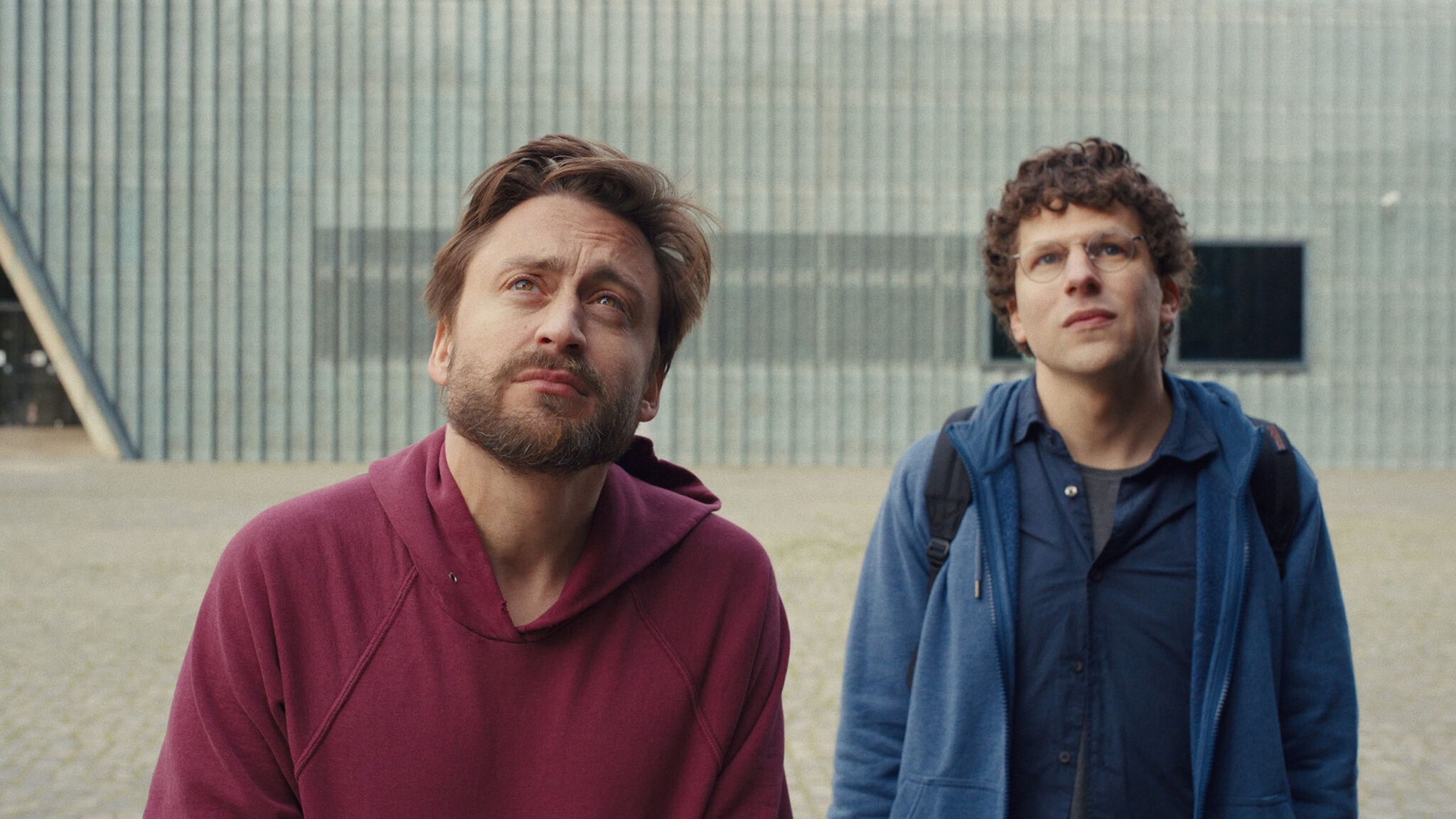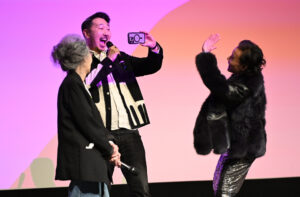By Bailey Pennick
One of the most exciting things about the Sundance Film Festival is having a front-row seat for the bright future of independent filmmaking. While we can learn a lot about the filmmakers from the 2024 Sundance Film Festival through the art that these storytellers share with us, there’s always more we can learn about them as people. This year, we decided to get to the bottom of those artistic wells with our ongoing series: Give Me the Backstory!
It almost feels like cheating to start this series for the 2024 Sundance Film Festival with a piece about “getting to know” Jesse Eisenberg. He’s been a part of the Fest for nearly 20 years both as a writer-director (2022’s When You Finish Saving The World) and as an actor.
“I think the first time I came to Sundance was as an actor with the movie The Squid and the Whale,” recalls Eisenberg. “It was such a wonderful experience and a perfect place for that extraordinary movie to premiere.” Since his debut outing at the 2005 Fest for Noah Baumbach’s now-classic film, Eisenberg’s ventured to Park City, Utah, for the premiere of several films, including The Double (2014), Adventureland (2009), and The End of the Tour (2015). But 2024 will be the first time he gets to experience an in-person Sundance Film Festival with a project featuring him behind the camera.
“As a writer-director, my previous film, When You Finish Saving The World, premiered at Sundance, but only online because of COVID,” he says. “I am so honored to be back to Sundance, this time in person.” Eisenberg’s sophomore feature, A Real Pain, is a funny and heartbreaking film about cousins (Eisenberg and Kieran Culkin) embarking on a tour through Poland following the death of their grandmother. It’s a complex look at familial relationships, growth, and coping mechanisms all against the backdrop of how the trauma of World War II radiates through generations.
The timeliness of this work isn’t lost on its creator as well. “I wrote the movie two years ago, but the world has changed quite a bit in the last two months in a way that makes my movie take on a greater relevance,” says Eisenberg. “The movie is completely apolitical, but it does provide some context about the Jewish-American experience and reconciliation, and I hope it can contribute to some of the important conversations we are all having now.”
Below, hear about the inspiration behind the U.S. Dramatic Competition film A Real Pain, working with Culkin, and Eisenberg’s son’s first reaction to hearing that he got into the 2024 Festival.

Tell us why and how you got into filmmaking.
My background is in stage acting. I consider my move to films as a very lucky break. As a teenager, I was only in plays in New York and was infrequently sent to audition for a commercial or movie. I consider my big break in film to be the first movie I was cast in, Roger Dodger, which carved out the path I am still on. It was a wonderful, gritty, funny, emotional, character-based New York independent film and it is still the exact type of project I seek out now. As for writing and directing, I have written scripts since I was 16 but only my plays have been produced, never my movies. Once I shifted my focus away from writing commercial comedy screenplays and started focusing on more personal stories, I found a much more satisfying avenue.
What was the biggest inspiration behind this film?
My initial inspiration for the movie was a thought experiment. For 20 years, I have struggled with — and written about — the following problem: How do I reconcile my modern daily challenges with my ancestors’ historical trauma? That is, how could I possibly feel bad about my little life when I come from survivors of global horrors? And the more I struggled with this question, the more I punished myself for even asking it.
When I started thinking about this story, I thought about setting these two mismatched cousins, who are both struggling with different degrees of pain, against the backdrop of the horrors of World War II. This allowed me to explore these themes in such a visually explicit way — viewing these modern American cousins, who are dealing with different versions of anxiety and depression, in the setting of their family’s wartime trauma. This stark contrast allowed me to implicitly ask these questions in a way that doesn’t feel didactic.
Who do you want this film to reach?
This movie is very personal and about my culture and family. But like anyone who makes a personal film, I hope it can feel universal to an audience. I hope it can speak to that feeling we all encounter in our lives where we question our own place in the world compared to those that came before us and paved our way. I have friends from many different parts of the world and often hear them tell a similar story to the one featured in this movie — struggling to reconcile their lives of safety and security with the traumas suffered by their forebears.
Films are lasting artistic legacies; what do you want yours to say?
My movie is explicitly about the legacy of this one particular family. My protagonists, Benji and David, are exploring the ancestors’ lives and trying to place themselves in the larger context of history. I suppose that I would love for this movie to pinpoint this moment in history to depict how these American men dealt with their past. It would be interesting to watch the movie in 20 years with my child to see if it overlaps in an emotionally relatable way.
Your favorite part of making the film? Memories from the process?
My favorite part of the movie was watching Kieran Culkin perform. He is a singular genius, especially as it relates to spontaneity. He does not come in with a pre-planned performance, but rather reacts and feels things in real time. That is absolutely thrilling. In certain scenes, I would ask him to improvise a take or two and they would often be so astoundingly funny and sharp and emotionally rich that I would literally have to turn away from the camera so that I was not seen laughing. In fact, there is a big scene in a cemetery halfway through the movie, and you can barely see my face because Kieran was so inventive and cutting that I had to turn away from the camera.
What was a big challenge you faced while making this film?
The movie was incredibly ambitious in a way I’ve never experienced. We were in a different location almost every day and every location was challenging. On a small budget, we filmed in five cities, in scenes that took place at two international airports, on airplanes, on trains, in several taxis, in the center of cities, at monuments in downtown Warsaw and Lublin, at various hotels, and even at my family’s small apartment in Krasnystaw, from which they fled 80 years ago. Most difficult but also most rewarding, perhaps, was filming at the Majdanek Concentration Camp. It took months of negotiations with the amazingly accommodating staff and script changes on my part and then figuring out a way to bring a whole crew into the camp, which meant wiring power and bringing equipment through some of the most sensitive, sacred rooms on the planet. It was an incredibly emotional day for our cast and crew and then, afterward, cathartic.
Tell us an anecdote about casting or working with your actors.
I based the character of Eloge, who is a survivor of the genocide against the Tutsis in Rwanda, on my friend Eloge Butera. The real Eloge is a brilliant, warm man who moved to Canada after surviving the genocide. In Canada, Eloge found a kinship with the Jewish community of Winnipeg because the older members of the community had survived the Holocaust. It made Eloge feel at peace to be among other survivors, and the Jewish community embraced him deeply. After I finished the script, I nervously sent it to Eloge in the hopes he would allow me to use his name and life story. Not only did he approve, but he and his wonderful wife, Simone, helped me with costumes, casting, dialogue, and even worked with our phenomenal actor Kurt Egyiawan on the role. On the day we were filming the scene at the concentration camp, Kurt and I received a text from Eloge that it was the anniversary of his grandmother’s murder in Rwanda. For me and Kurt, it put that day’s work into a very personal light in a way that was both heartbreaking and heartwarming.
What is something that all filmmakers should keep in mind in order to become better cinematic storytellers?
Oh boy. When I was editing my first movie, When You Finish Saving The World, I realized I had gotten every single shot I wanted, but I wished I had more footage as a cushion. We were using 16mm film, on which we had a limit, and shooting during the height of COVID, working only eight- to ten-hour days, but I wish I pushed for more shots. We had one of the greatest composers in the world, Emile Mosseri, and I kicked myself for not getting more footage to use for montages scored by Emile. On my new movie, I decided to shoot on digital and to use two cameras as often as possible in an attempt to correct my previous mistake. My advice to filmmakers would be just that — even if you have a very specific vision for the movie, shoot more than you think you need. I wish I had.
Why is filmmaking important to you? Why is it important to the world?
Films are such a powerful, universally accessible way to tell intimate stories. When I think about the value it has in my life, I am drawn to the idea that it allows me to express myself through fiction. As cultural discourse becomes increasingly polarized, I take solace in the opportunity to make fictional stories that can transcend divisiveness while still expressing my thoughts.
If you weren’t a filmmaker, what would you be doing?
My parents, my wife, and my friends are teachers, and I suppose I would have also followed that course if I didn’t pursue the arts. Of course, there are some very broad overlaps, in that teaching is a formalized conversation that imparts one perspective onto another. The thing I love so much about movies — the exploration of complicated social dynamics and themes — would be, I’m sure, just as satisfying in a classroom setting.
Who was the first person you told when you learned you got into the Sundance Film Festival?
I was with my sweet child in a Home Depot, picking out paint swatches for their bedroom, when Kim Yutani called me to give me the great news. After I cried and thanked her 4,000 times like a mad man, we hung up and I tried to explain to my child what it all meant. They listened briefly and then said, “Great, can we go back to the swatches?” Equal parts climactic and anticlimactic.







